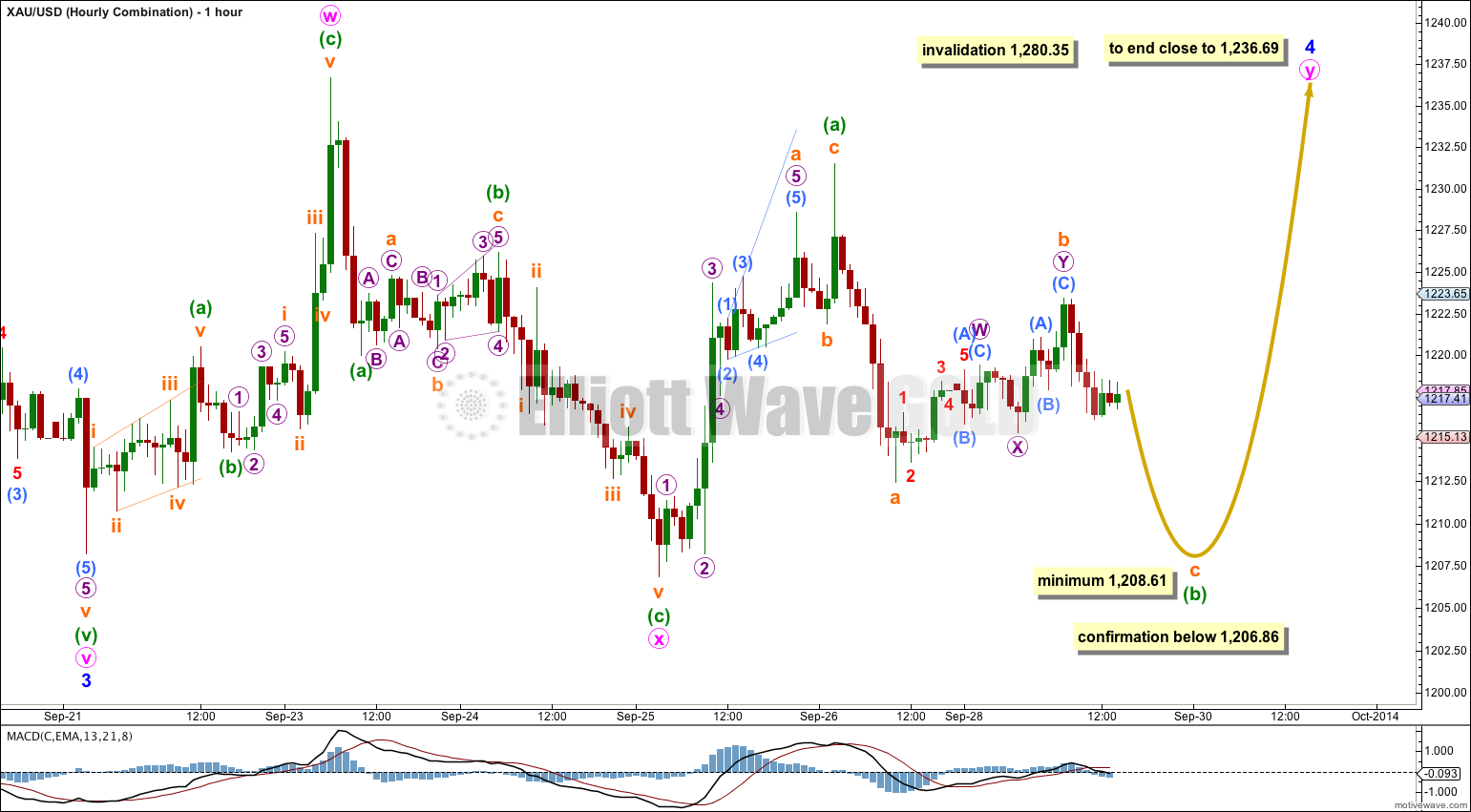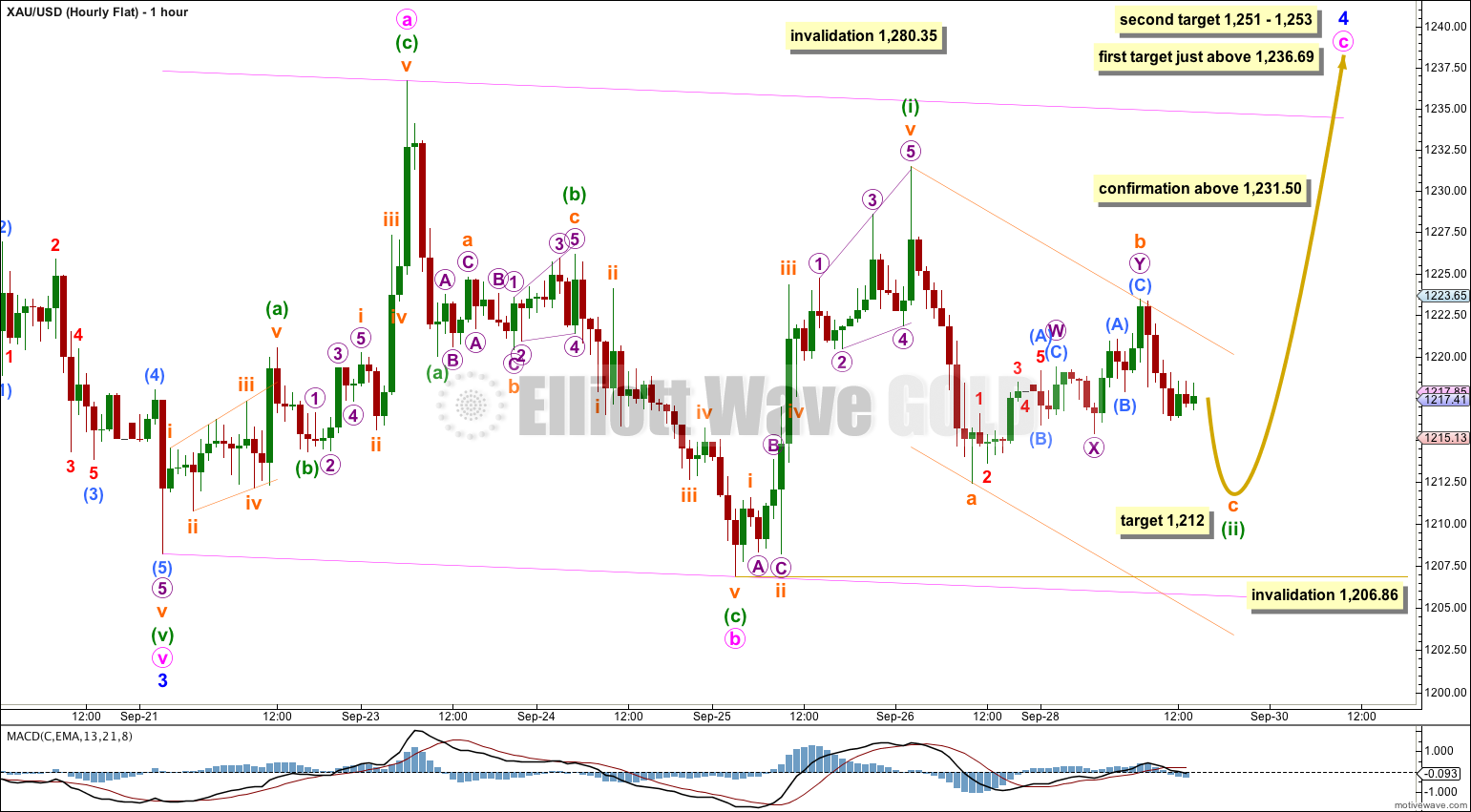Last Elliott wave analysis expected the new week to begin with a continuation of the current correction. Gold remains in a consolidation phase, as expected.
Summary: This correction is incomplete and now looks most likely that a triangle is unfolding so we shall see just sideways movement. Less likely but still possible is a flat correction which may move higher to 1,251 – 1,253. When the correction is complete the breakout should be downwards. I now expect this fourth wave correction may end this Thursday.
Click on charts to enlarge.
Main Wave Count
On the weekly chart extend the triangle trend lines of primary wave 4 outwards. The point in time at which they cross over may be the point in time at which primary wave 5 ends. This does not always work, but it works often enough to look out for. It is a rough guideline only and not definitive. A trend line placed from the end of primary wave 4 to the target of primary wave 5 at this point in time shows primary wave 5 would take a total 26 weeks to reach that point, and that is what I will expect. Primary wave 5 has begun its 12th week.
The black (B)-(D) trend line is now clearly breached on the daily chart, and also clearly breached on the weekly chart. This is significant.
At 956.97 primary wave 5 would reach equality in length with primary wave 1. Primary wave 3 is $12.54 short of 1.618 the length of primary wave 1, and equality between primary waves 5 and 1 would give a perfect Elliott relationship for this downwards movement.
However, when triangles take their time and move close to the apex of the triangle, as primary wave 4 has (looking at this on a weekly chart is clearer) the movement following the triangle is often shorter and weaker than expected. If the target at 956.97 is wrong it may be too low. In the first instance I expect it is extremely likely that primary wave 5 will move at least below the end of primary wave 3 at 1,180.40 to avoid a truncation. When intermediate waves (1) through to (4) within primary wave 5 are complete I will recalculate the target at intermediate degree because this would have a higher accuracy. I cannot do that yet; I can only calculate it at primary degree.
Minor wave 3 is $9.65 longer than 1.618 the length of minor wave 1. This variation is less than 10% the length of minor wave 3 and so I would consider it an acceptable Fibonacci ratio. Just.
Movement comfortably below 1,180.84 would provide further confidence in this main wave count as at that stage an alternate idea which sees primary wave 4 as continuing would be invalidated.
I have drawn a Fibonacci retracement the length of minor wave 3. Minor wave 4 has so far reached up to the 0.236 at 1,234.34. If minor wave 4 continues as a triangle this will be its maximum depth. If it continues as a flat correction then it may yet move higher to the 0.382 at 1,250.78 Fibonacci ratio. If it continues as a combination then about the 0.236 Fibonacci ratio will be its maximum depth.
Draw a channel about intermediate wave (1): draw the first trend line from the lows labeled minor waves 1 to 3, then place a copy on the high labeled minor wave 2. If it completes as a flat correction minor wave 4 may find resistance and may end about the upper edge of this blue channel. If it overshoots the channel it should find some resistance at the upper blue trend line before breaking above it.
There is a nice morning doji star on this daily chart which supports this wave count. A morning doji star is a bottom reversal pattern, indicating the prior bear trend of minor wave 3 should change to a new trend. This new trend may be either upwards or sideways, and the wave count expects it is sideways.
There are still three structural possibilities for this fourth wave correction: a flat, a triangle or a combination. If fourth wave correction continues for another four days / sessions it may end in a total Fibonacci eight days, next Thursday. This expectation is now the same for all three hourly wave counts.
All three hourly wave counts below are viable and all three scenarios must be considered. At this stage on the daily chart it looks like a triangle is most likely. Today I am ranking the three hourly wave counts in order of probability: triangle, combination, flat correction.
Hourly Wave Count – Triangle
Minor wave 4 may still be unfolding as a triangle.
Within it minute wave b is a 105% correction of minute wave a and minute wave c is a 83% correction of minute wave b.
The target for minute wave d to end is at 1,212 where minuette wave (c) would reach 0.618 the length of minuette wave (a).
For a contracting triangle minute wave d may not move beyond the end of minute wave b at 1,206.86. For a barrier triangle minute wave d may end about the same level as minute wave b as long as the b-d trend line remains essentially flat. In practice this means minute wave d may end slightly below 1,206.86 and this invalidation point is not black and white.
Minute wave e must subdivide as a three or a triangle and it may not move beyond the end of minute wave c for a contracting or barrier triangle. The upper invalidation point at 1,231.50 is black and white. Minute wave e would likely end short of the a-c trend line and must subdivide as a corrective structure, either a single or double zigzag, or possibly a triangle so that minor wave 4 could be a nine wave triangle.
This triangle idea and the combination below see the upwards wave labelled here minute wave c as a zigzag. This does not have as good a fit was the flat correction seeing that movement as a five wave impulse.
When fourth waves subdivide as triangles then the following fifth wave is sometimes quite brief. If this hourly wave count shows to be correct I will expect minor wave 5 to be equal in length with minor wave 1 at 64.87, or maybe shorter at 0.618 the length of minor wave 1 at 40.09.
Hourly Wave Count – Combination
At this stage a combination is also entirely possible, and with the duration of minuette wave (b) this idea is now taking on a more typical look.
It is my experience over the years that when one expects a triangle is unfolding it is always necessary to consider a combination alongside it. Often what you think is a triangle completing turns out to be a combination, as the triangle invalidates itself just before the structure ends.
The first structure in the double combination was a zigzag labeled minute wave w. The double is joined by a three, a zigzag, in the opposite direction labeled minute wave x. The second structure in the double combination may only be either a flat or triangle labeled minute wave y.
Minute wave y looks like it would most likely be a flat correction.
Within the flat correction minuette wave (b) must reach a minimum 90% length of minuette wave (a) at 1,208.61. Minuette wave (b) may move beyond the start of minuette wave (a) below 1,206.86. Movement below 1,206.86 is not required for this wave count, but if it happens the first two wave counts would be invalidated and this third option of a combination would be the only wave count for this correction.
The purpose of double combinations is to move price sideways and take up time. The second structure in the double normally ends close to the end of the first structure. Minute wave y would be expected to end close to 1,236.69.
Hourly Wave Count – Flat
The duration of minuette wave (ii) now makes this wave count look strange. If minor wave 4 is unfolding as a flat correction then the subdivisions within minute wave c should not be taking this long. It is possible though.
The upwards movement of minuette wave (i) fits best as a five wave impulse. The ending expanding diagonal of subminuette wave v fits perfectly. However, there are no adequate Fibonacci ratios between subminuette waves i, iii and v.
Minuette wave (ii) is still an incomplete zigzag. At 1,212 subminuette wave c would reach 0.618 the length of subminuette wave a.
Redraw the small channel about the incomplete zigzag of minuette wave (ii). After the structure is complete with some downwards movement then a breach of this channel with upwards movement would provide confirmation that minuette wave (ii) is over and minuette wave (iii) upwards should have begun.
Minuette wave (iii) must make a new high above the end of minuette wave (i) at 1,231.50 and should show an increase in upwards momentum.
Movement above 1,231.50 would invalidate the triangle wave count and provide some confidence in this flat wave count.
Minute wave c of a flat correction is extremely likely to move at least slightly above the end of minute wave a at 1,236.69 to avoid a truncation and a very rare running flat.
At 1,253 minute wave c would reach 1.618 the length of minute wave a. This is just $2 above the 0.618 Fibonacci ratio of minor wave 3 at 1,251.
Minuette wave (ii) may not move below the start of minuette wave (i) at 1,206.86.
This analysis is published about 04:02 p.m. EST.





well…. it looked like it… until I looked into it further and can still see all three options open.
this is exactly the problem with corrections, particularly fourth waves and B waves. there are so many possibilities.
like I said at the beginning of this consolidation phase; I will have alternates and the wave count will change as the correction unfolds.
but I can be confident of two things:
1. its not over yet
2. the breakout when its done will be downwards.
Hi Lara,
I’ve been noticing you haven’t been addressing Minor Wave 5 / Intermediate Wave 1 projections for ending. Is it possible to address this in your next update? Also I look forward to your expanding more on the combination within Minor 4 since it has been confirmed. Good job presenting the possibilities for us!
I would expect minor wave 5 most likely to be equal in length with minor wave 1 at $64.87 in length.
I don’t have a target for minor wave 5 to end intermediate wave (1) on the charts because I can’t calculate where it ends until I know where it begins.
The structure of minor wave 4 may also play a role in target calculation. Fifth waves following triangles are often rather brief. If minor wave 4 turns out to be a barrier triangle then the fifth wave will be either a very short wave, or a very long extension.
So not until minor wave 4 is over will I have enough information to figure out what will happen for minor wave 5. Hence the lack of target on the daily chart.
So we now have confirmation we are in the “Hourly Wave Count – Combination” since this chart (middle chart above) states confirmation below 1206.86, or is this mislabeled and should say invalidation like the other charts?
Can you catch us up on GDX?
And silver please ?